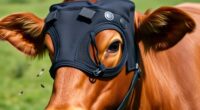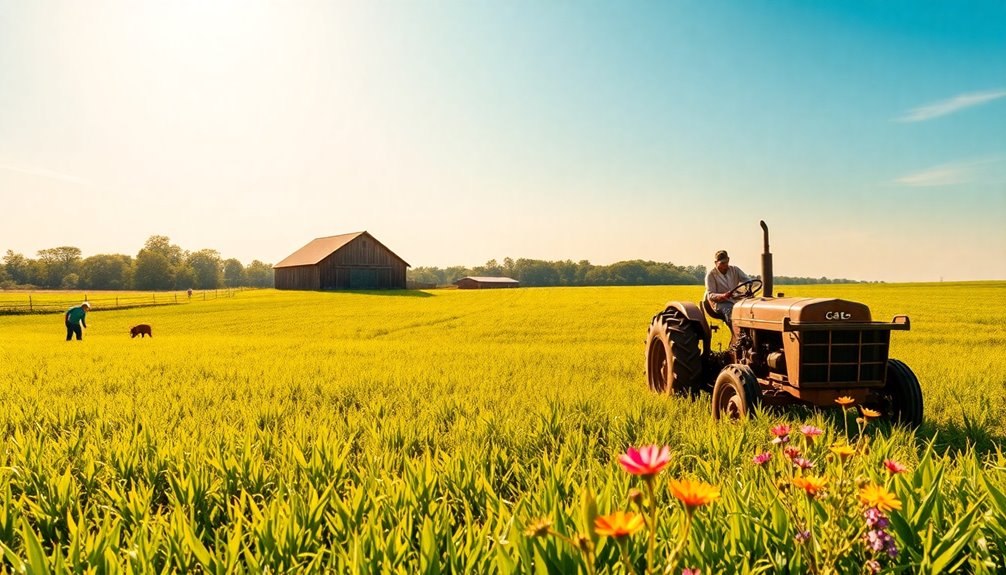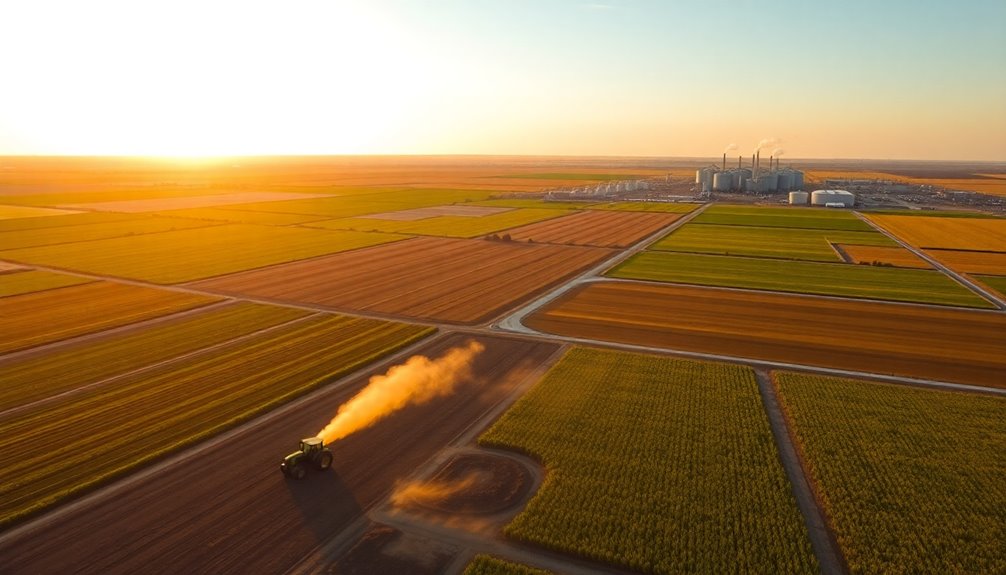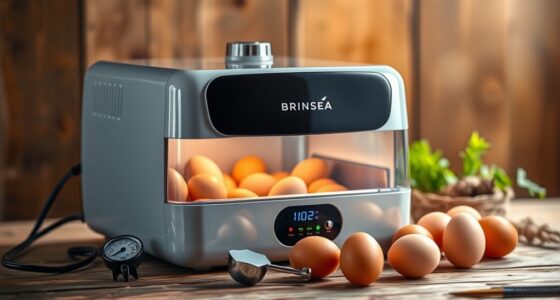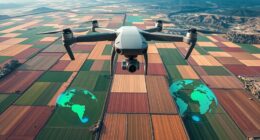To use drones for crop scouting on a budget, start by choosing affordable models with reliable flight time and good cameras, like refurbished or DIY kits. Maximize limited funds with free flight planning and image analysis software, and safeguard your gear with DIY cases. Regular maintenance and learning safety rules make certain of smooth flights. Keep costs low by using smartphone cameras and seeking deals online—stick with these tips, and you’ll uncover even more ways to save.
Key Takeaways
- Choose budget-friendly drones with reliable cameras and good flight time, and consider refurbished or seasonal sale options.
- Utilize free or low-cost flight planning and data analysis software like DroneDeploy, Pix4Dcapture, or QGIS.
- Perform regular maintenance and DIY repairs to extend drone lifespan and ensure optimal performance.
- Use smartphone cameras and DIY drone kits to customize and reduce costs for crop monitoring needs.
- Prioritize proper pre-flight planning, weather checks, and adherence to local regulations to maximize safety and data quality.
Choosing the Right Drone for Your Needs and Budget

When selecting a drone for crop scouting, it’s important to contemplate both your specific needs and your budget. Start by considering drone regulations in your area, as some regions have restrictions on drone size and flight altitude. If you plan to use aerial photography to monitor your crops, look for models with good camera stability and resolution. Budget-friendly options often feature basic sensors, but more advanced drones may include multispectral cameras for detailed crop health analysis. Determine whether you need a drone with longer flight times or quick setup capabilities. Balancing your budget with essential features ensures you get a drone that meets your crop monitoring needs without overspending. Always research your local regulations before making a purchase to stay compliant. Additionally, understanding how wave and wind can affect drone stability and flight performance is crucial for effective crop scouting, especially in areas prone to wind disturbances.
Understanding Basic Drone Features for Crop Monitoring

To effectively monitor your crops with a drone, understanding its basic features is essential. Key features include sensor calibration, which ensures accurate data collection, and flight stabilization, which keeps your drone steady during flights. Proper sensor calibration involves adjusting sensors to detect plant health and soil conditions accurately. Flight stabilization helps prevent shaky footage and maintains consistent altitude and position, especially in windy conditions. Additionally, being aware of color accuracy tips can help you manage stress and operate your drone more effectively. Having the right battery backup can also ensure uninterrupted monitoring sessions, even during power outages or extended flights. Regular maintenance and understanding your drone’s cognitive functions can further enhance performance and reliability during crop scouting. Ensuring your drone’s filtration systems are clean can prevent clogs and maintain optimal operation.
Tips for Finding Affordable Drone Options and Deals
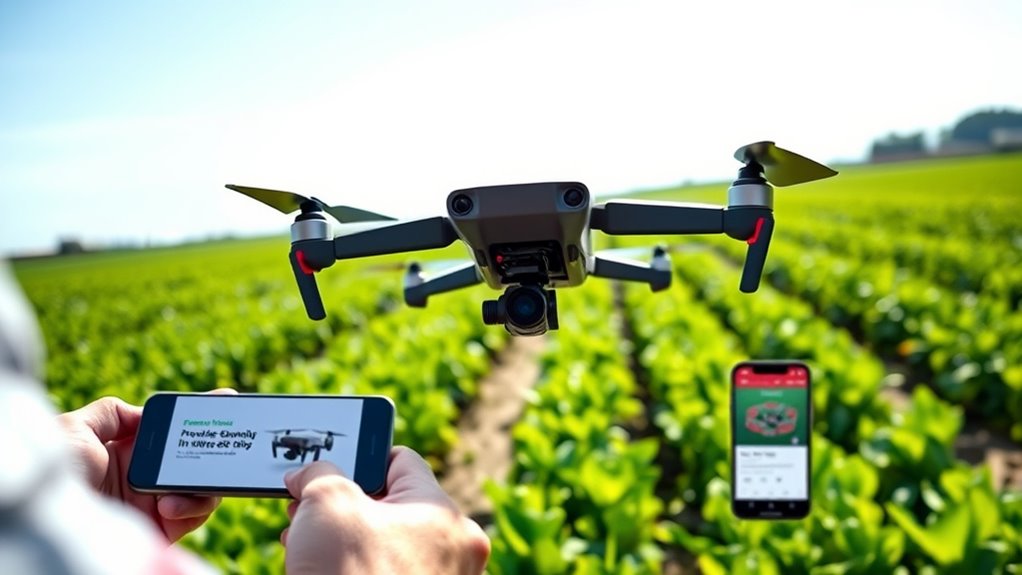
Finding an affordable drone that meets your crop monitoring needs doesn’t mean sacrificing quality. To get the best value, look for budget friendly drones that deliver reliable performance without breaking the bank. Keep an eye out for affordable drone deals on reputable online stores, seasonal sales, or refurbished models. Signing up for newsletters from drone retailers can alert you to discounts and special offers. Consider models from trusted brands known for durability and ease of use, even if they’re slightly older. Comparing prices across different platforms helps ensure you’re getting the best deal. Remember, patience pays off—waiting for sales or bundles can save you money. Additionally, understanding types of gumball machines can inspire ideas for customizing your drone setup for better performance. By doing your research, you’ll discover effective, affordable drones that support your crop scouting without overspending. Necessary cookies and other data collection methods can enhance your shopping experience by providing personalized recommendations.
Essential Accessories to Enhance Your Drone Capabilities

To get the most out of your drone for crop scouting, consider investing in essential accessories like a high-quality camera to capture detailed images. Extra batteries ensure you can cover larger areas without interruptions, while protective cases keep your gear safe during travel. These upgrades help you work more efficiently and safeguard your investment on a budget. When selecting accessories, pay attention to essential oils, which can be used to keep your equipment in good condition and promote a clean workspace. Additionally, understanding the different headphone jacks can help you choose the right audio accessories for your drone or related equipment. Incorporating best anime movies into your downtime can also inspire creative solutions for innovative drone applications. Regularly using aromatherapy oils in your workspace can help maintain a fresh environment and boost your overall productivity, especially when managing small spaces effectively.
High-Quality Camera Options
A high-quality camera can dramatically improve your drone’s crop scouting capabilities by capturing clear, detailed images essential for accurate analysis. To maximize image quality during drone flight, look for cameras with high resolution and good low-light performance. Camera stabilization is vital, as it reduces blurriness caused by drone movement, ensuring sharp images even in windy conditions. Investing in gimbals or stabilization mounts can make a noticeable difference. When choosing a camera, consider models that offer adjustable focus and multiple shooting modes, like infrared or multispectral options, for more comprehensive crop health assessments. Remember, a stable, high-resolution camera allows you to identify issues early, saving you time and resources while helping you make informed decisions on a budget. Additionally, understanding special occasions related to agricultural milestones can help you plan optimal times for scouting and data collection. Incorporating camera features such as remote control and real-time image transmission can further enhance your efficiency during field inspections. Moreover, selecting cameras with advanced stabilization technology can significantly improve image clarity in challenging flying conditions. In addition, choosing cameras with weather-resistant designs can ensure durability in outdoor environments, extending your equipment’s lifespan. Considering cost-effective options can also help you stay within budget while still achieving reliable results.
Extra Battery Power
Having extra batteries on hand is one of the most cost-effective ways to extend your drone’s scouting time and maximize your investment. Extra battery power guarantees you don’t have to pause operations while waiting for a recharge, allowing for continuous, efficient flights. With additional batteries, you can achieve extended flight time, covering more ground without interruption. This is especially useful during long scouting sessions when monitoring large fields or multiple areas. Carrying spare batteries is affordable and simple, making it a smart upgrade for anyone on a budget. It boosts productivity, reduces downtime, and helps you gather thorough data in a single session. Investing in extra batteries is a straightforward step toward getting the most out of your drone for crop scouting. Reliable power sources are essential for maintaining consistent performance and ensuring safety during extended flights. Additionally, choosing compatible batteries can further enhance your drone’s efficiency and longevity.
Protective Drone Cases
Investing in a protective drone case is a smart way to safeguard your equipment and extend its lifespan. Protective drone cases are designed to provide sturdy drone storage, shielding your drone from impacts, dust, and moisture during transport and storage. They keep your drone secure, reducing the risk of damage when you’re not flying. With a durable case, you can confidently carry your drone across fields or store it safely in your shed. Look for cases with custom foam inserts that fit your drone model snugly, ensuring it stays protected from shocks. A good protective drone case isn’t just about safety; it’s about preserving your investment so your drone remains reliable for crop scouting season after season.
Using Free and Low-Cost Software for Flight Planning and Image Analysis

Fortunately, there are several free and low-cost software options that make drone flight planning and image analysis accessible for budget-conscious farmers. These tools help you stay compliant with agricultural drone regulations and guarantee drone flight safety without extra costs. Apps like DroneDeploy and Pix4Dcapture offer user-friendly interfaces for planning flights, setting waypoints, and managing flight paths efficiently. For image analysis, open-source software such as QGIS or Google Earth Engine allows you to process and interpret crop data effectively. Using these affordable options, you can maximize your drone’s potential while adhering to safety guidelines and legal requirements. This approach not only saves money but also empowers you to make data-driven decisions for better crop management.
Best Practices for Safe and Effective Drone Flights

To guarantee your drone flights are safe and effective, it’s essential to follow established best practices that minimize risks and optimize data collection. Start by checking weather conditions; avoid flying in high winds, rain, or fog, which can compromise stability and safety. Familiarize yourself with legal regulations in your area, such as altitude limits and no-fly zones, to stay compliant and avoid penalties. Always perform pre-flight inspections of your drone to ensure batteries are charged and controls are responsive. Maintain visual line of sight and avoid flying over people or private property without permission. Planning your flights carefully, considering weather and legal factors, helps you gather reliable crop data while keeping everyone safe. Following these practices ensures efficient, responsible drone use on your farm.
How to Maximize Crop Insights Without Expensive Equipment
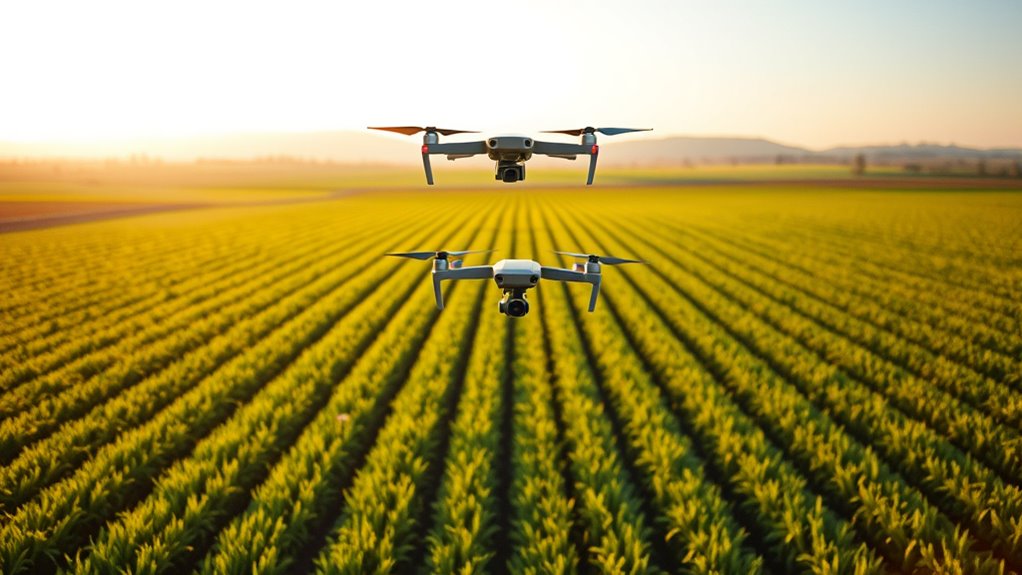
You don’t need expensive gear to gather valuable crop insights. Using DIY drone kits or your smartphone camera can provide clear images without breaking the bank. Focus on analyzing your data efficiently to make the most of what you have.
Using DIY Drone Kits
While high-end drone systems can be costly, DIY drone kits offer a practical and affordable way to gather valuable crop data. With DIY assembly, you can customize your drone to suit your specific scouting needs without breaking the bank. Hobbyist kits provide all the essential components, making it accessible even if you’re new to drone technology. Building your drone from a kit allows you to understand its mechanics and optimize its performance for agricultural purposes. Plus, assembling your drone encourages hands-on learning, which can improve your ability to troubleshoot and upgrade as needed. Overall, DIY drone kits strike a balance between affordability and functionality, empowering you to conduct effective crop scouting without investing heavily in commercial solutions.
Leveraging Smartphone Cameras
Building on the flexibility of DIY drone kits, incorporating smartphone cameras can substantially enhance your crop scouting efforts without extra costs. With a good quality phone, you can capture high-resolution images that aid in crop pest detection, spotting early signs of infestations before they spread. You can also perform soil nutrient analysis by taking detailed photos of plant health and color variations across your fields. Smartphone cameras are portable and easy to operate, allowing you to quickly survey large areas without expensive equipment. By regularly capturing images from different angles, you’ll gather valuable insights into crop health and soil conditions. This simple approach makes precision agriculture more accessible, helping you make informed decisions without breaking the bank.
Analyzing Data Efficiently
Maximizing crop insights without expensive equipment requires smart data analysis strategies that make the most of what you already have. Focus on organizing your drone imagery and field observations systematically to identify patterns in crop health. Use free or affordable software tools to analyze data, such as basic image processing apps or open-source platforms, which can reveal stress signs, pest damage, or nutrient deficiencies. Prioritize key areas needing attention, avoiding data overload. Regularly reviewing crop health trends helps you catch issues early, saving costs. Combining drone data with simple ground checks enhances accuracy. By refining your data analysis approach, you can improve decision-making and crop management without breaking the bank. Efficient analysis turns basic data into valuable insights, boosting your crop productivity on a budget.
Maintaining and Troubleshooting Your Drone on a Budget

Regular maintenance is essential to keep your drone functioning properly without breaking the bank. Proper care extends battery life and ensures smooth operation. Start with battery maintenance by regularly checking for swelling, cleaning contacts, and storing batteries in a cool, dry place. Keep firmware updated to improve performance and fix bugs—many updates are free and can be done via the drone’s app or software. Troubleshooting common issues involves inspecting propellers for damage, recalibrating sensors, and resetting connections if needed. To stay on budget, perform basic repairs yourself, like replacing propellers or tightening screws.
Regular drone maintenance boosts performance, extends battery life, and saves money through simple DIY repairs.
- Regularly inspect and clean batteries and connectors
- Download firmware updates from official sources
- Calibrate sensors and check for physical damage
Building Skills and Knowledge to Make the Most of Your Drone Investment
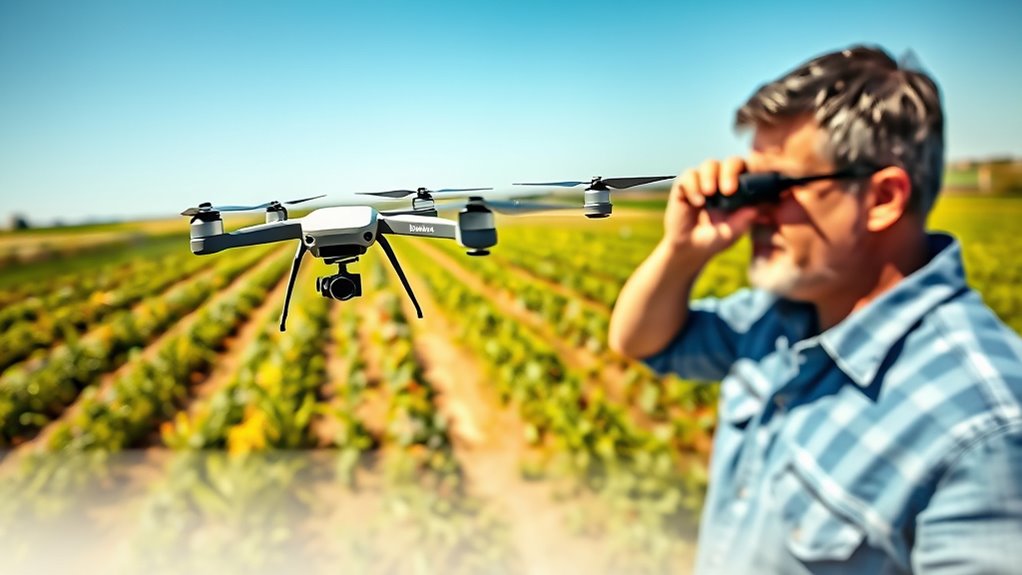
To get the most out of your drone for crop scouting, investing time in developing your skills and knowledge is essential. Start by understanding drone safety practices to prevent accidents and damage. Familiarize yourself with legal considerations, such as local regulations and airspace restrictions, to avoid fines or legal issues. Take online courses or attend workshops to learn drone operation and data interpretation. Practice flying in open areas to build confidence and precision. Staying informed about updates in drone laws ensures you’re compliant. Building your skills helps you capture better images, analyze crop health more effectively, and operate safely within the law. With proper knowledge, you’ll maximize your drone’s potential while minimizing risks and legal pitfalls.
Frequently Asked Questions
What Legal Restrictions Exist for Drone Use in Agricultural Areas?
You need to be aware of FAA regulations and local restrictions when flying drones in agricultural areas. The FAA requires drone pilots to register their aircraft and follow rules like flying below 400 feet and avoiding manned aircraft. Local restrictions may include no-fly zones or altitude limits, so always check with local authorities before operating. Staying compliant guarantees safe, legal drone use for crop scouting.
How Can I Train Myself to Operate a Drone Safely and Effectively?
Imagine you’re the pilot of your own high-tech spaceship, mastering drone operations. To train yourself safely and effectively, start with flight simulation software to practice controls without risk. Learn drone maintenance basics to keep your equipment in top shape. Then, take small, supervised flights outdoors, gradually increasing complexity. This approach builds confidence, sharpens skills, and guarantees safe operation every time you fly your drone.
Are There Community Resources or Clubs for Budget Drone Users?
You can find great community resources for budget drone users by joining local drone meetups and online drone forums. These groups often share tips, advice, and even affordable equipment options, helping you improve your skills without breaking the bank. Participating actively in these communities allows you to learn from experienced pilots, troubleshoot issues, and stay motivated, all while keeping your costs low and your knowledge growing.
How Can I Ensure Data Privacy When Sharing Drone Imagery?
You want to protect your drone imagery when sharing data. To guarantee privacy, use data encryption to secure your files during transfer and storage. Implement access controls so only authorized people can view or download your images. Regularly update your software and passwords, and be cautious about sharing sensitive data. These measures help keep your crop scouting data private and prevent unauthorized access.
What Are Cost-Effective Ways to Upgrade Drone Batteries and Extend Flight Time?
To upgrade your drone batteries and extend flight time, look into battery upgrades designed for longer flights, such as higher-capacity or more efficient cells. You can also carry multiple batteries to swap out during missions, minimizing downtime. Regularly maintain and calibrate your batteries to optimize performance. Investing in portable charging stations can also help extend your drone’s operational time without significant costs, making your crop scouting more efficient and budget-friendly.
Conclusion
Think of your budget drone as a trusty compass guiding you through the fields—sure, it’s not the priciest, but with the right skills, it can lead you to valuable crop insights. Just like a farmer who learns to read the land without fancy tools, you can maximize your drone’s potential without breaking the bank. With smart choices and steady practice, you’ll harvest clearer, healthier crops—proving that sometimes, the simplest tools grow the best results.


